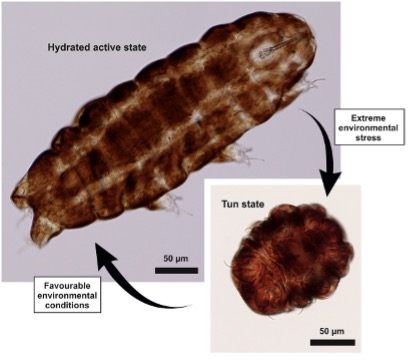By Vidya Rajan, Columnist, The Times
 In the annals of the ecosystem’s version of Ripley’s Believe It Or Not is a long list of organisms that are considered over-performers: tough, enduring and even thriving in environmentally adverse conditions. Most endure in state known as cryptobiosis (also called anabiosis), which means “mysterious or enigmatic” and refers to the difficulty in telling if it is, in fact, still alive. Take a seed, for example. The seed is an embryo surrounded by food, but subjected to mechanisms that prevent germination until the environment is suitable for the growth of a baby plant. This enigma extends to a collection of other environmentally resilient organisms.
In the annals of the ecosystem’s version of Ripley’s Believe It Or Not is a long list of organisms that are considered over-performers: tough, enduring and even thriving in environmentally adverse conditions. Most endure in state known as cryptobiosis (also called anabiosis), which means “mysterious or enigmatic” and refers to the difficulty in telling if it is, in fact, still alive. Take a seed, for example. The seed is an embryo surrounded by food, but subjected to mechanisms that prevent germination until the environment is suitable for the growth of a baby plant. This enigma extends to a collection of other environmentally resilient organisms.
The most famous of the resiliency brigade are members of the prokaryotic domain Archaea, that live in hellish places like mine runoffs, hot geysers, deep in the darkest and coldest parts of the ocean, and other places where their kryptonite, oxygen, does not penetrate. Eukaryotic multicellular animals, the metazoans, also show amazing endurance which include the ability to lower metabolic rates during summer (aestivation) or winter (hibernation) or intermittently (brumation or torpor) or to slow down development (diapause). In this article, I will examine a more extreme method of suspended animation which requires metabolic activity to be brought to a near-halt, and the animals – the tardigrades – that best exemplify the several cryptobiotic mechanisms.
Variously known as “moss piglets” and “water bears”, tardigrades are a pretty indestructible animal [1]. Here’s a quote from Wikipedia: “Tardigrades are usually about 0.5 mm (0.020 in) long when fully grown. They are short and plump, with four pairs of legs, each ending in claws (usually four to eight) or suction disks. Tardigrades are prevalent in mosses and lichens and feed on plant cells, algae, and small invertebrates.”[2]. They are cute as well as resilient. They do not tolerate heat well, but cope with cold (cryobiosis), lack of oxygen (anoxybiosis), chemical stress (chemobiosis), and dehydration (anhydrobiosis). Figure 1 below summarizes the methods tardigrades use to overcome environmental stressors.

Figure 1: Summary of cryptobiotic states of tardigrades. The various mechanisms of endurance of tardigrades include diapause (egg), cyst formation, tun formation (anhydrobiosis, osmobiosis, and possibly chemobiosis), formation of rigid elongated bodies (anoxybiosis), and contracted bodies (cryobiosis). The tun and cryobiotic forms are unusually resistant. Credit: Figure reproduced from https://www.sciencedirect.com/science/article/pii/S1095643320302439 under a Creative Commons CC.BY.4.0 license.
Under environmental stress conditions of desiccation (anhydrobiosis), osmotic shock (osmobiosis), and presence of environmental toxins (chemobiosis), tardigrades lose up to 97% of their body water and curl up into a so-called “tun” state (Figure 2). Other organisms that perform this desiccation sleight-of-hand are rotifers and nematodes, and they can perform this trick in egg, juvenile, or adult stages, tiding them over unfavorable conditions. In the tun state, tardigrades can survive freezing in liquid nitrogen (-70oC) and exposure to cosmic radiation [3]. However, when exposed to oxygen depletion (anoxybiosis) and extremely low temperatures (cryobiosis), tardigrades do not form tuns. When oxygen-depleted, tardigrades become elongated and turgid. When exposed to the cold, tardigrades contract in size.

Figure 2: Light micrographs of the limno-terrestrial eutardigrade Ramazzottius varieornatus in the active state (dorsal view) and tun state (ventral view); anterior faces right in both aspects.
Credit: Figure reproduced from https://www.sciencedirect.com/science/article/pii/S1095643320302439 under a Creative Commons CC.BY.4.0 license.
What are the mechanisms that underlie these astonishing demonstrations of biological resilience? The surprise is that there is no surprise. Many of these mechanisms are, in fact, in quite widespread use by other life-forms.
Take the use of the sugar trehalose that tardigrades to protect against desiccation and osmotic shock. Trehalose is made by joining two α-D-glucose molecules through an acid-hydrolysis-resistant α-1-1 bond, and is one of many compounds – sorbitol, mannitol, proline, glutamic acid, sucrose – which are osmotically active. They absorb water to make a glass-like amorphous substance which stabilizes membranes and prevents damaging ice-crystal formation in cold temperatures. Bacteria, fungi, and even the “resurrection” plant, Selaginella, uses trehalose to survive drying out. Trehalose enzymes are distributed widely [4]. In addition, trehalose is the most abundant sugar in insect hemolymph and is also present in honey. In varroa-mite parasitized drone prepupae trehalose levels were lower, and trehalose breakdown enzyme levels were higher. This was attributed to the greater energy requirements in parasitized bees, but the lower levels of trehalose may also mean lower energy for mobilization by the parasitized prepupae.
To go back to tardigrades: Their resilience is also genetically-based, with tardigrade genome DNA being as odd as they are. Fully one-sixth of the genome has been scavenged by horizontal gene transfer from other organisms, including archaea, bacteria, fungi, and plants [1]. Tardigrades are not alone in the animal kingdom in having sticky fingers for purloining beneficial genes and body parts, but they are certainly amongst the most prolific. Among the stolen sequences are genes for stress tolerance, production of heat-shock proteins, and DNA repair enzymes to fix radiation damage. No surprises there. But most of the purloined genes originate from bacteria, which is surprising, because bacterial genes are quite distinct in their organization and regulation from multicellular eukaryotic genes. Tardigrades appear to have overcome the regulatory difficulties by tinkering with codon usage and positioning the bacterial-derived genes close to their own indigenous sequences thereby retrofitting the bacteria genes with metazoan characteristics [5]. This is stunning, genetically speaking, and points to a nimble, assimilative genome, making tardigrades the melting pot of the animal world. Diversity builds strength and resilience in genomes as well as societies, apparently.
In April 2019, a private Israeli lunar lander, the Beresheet, carrying a DVD library, DNA samples, and dehydrated tardigrades crash-landed on the moon. In their dehydrated state, those tardigrades may endure until they are rehydrated by future astronauts of the human or an alien kind. Several charmingly named previous missions, TARDIS and TARDIKISS among them, examined the effect of exposure to the vacuum of space and cosmic radiation on tardigrades. Space they could handle, but cosmic radiation was tougher: only a third of them revived, but these even reproduced. But the conditions on the moon are dry and cold and the tardigrades may survive in a tun state and remain forever entombed in their own bodies.
Then again, with tardigrades, maybe we should expect the unexpected.
- E., Y., Inside the Fascinating Genome of the World’s Toughest Animal, in The Atlantic. 2015, @theatlantic.
- Tardigrade – Wikipedia. 2021; Available from: https://en.wikipedia.org/wiki/Tardigrade.
- Møbjerg, N. and R.C. Neves, New insights into survival strategies of tardigrades. Comp Biochem Physiol A Mol Integr Physiol, 2021. 254: p. 110890.
- Avonce, N., et al., Insights on the evolution of trehalose biosynthesis. BMC Evolutionary Biology, 2006. 6(1): p. 1-15.
- Boothby, T.C., et al., Evidence for extensive horizontal gene transfer from the draft genome of a tardigrade. PNAS, 2015. 112: p. 15976–15981.






